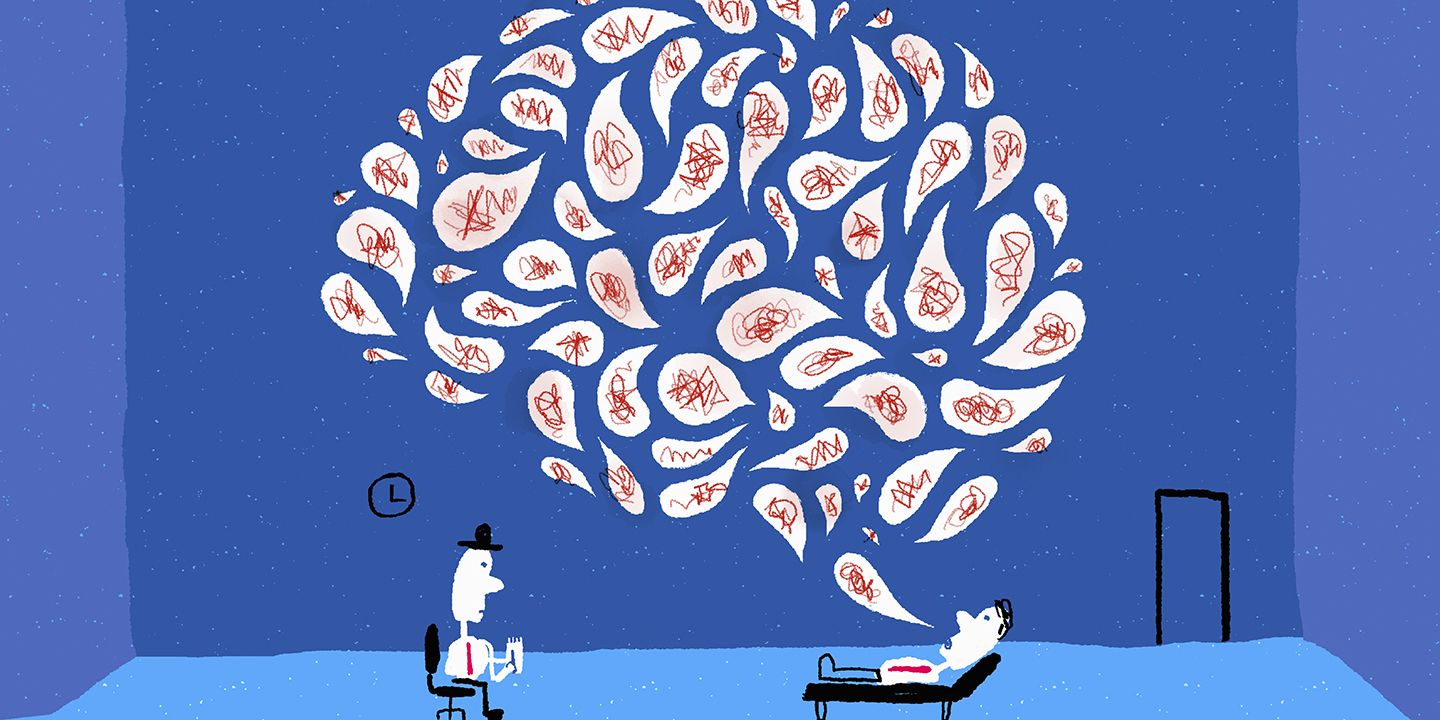
Maria, my patient, is neatly dressed in a skirt and blouse. Her bright coral nail polish, designer handbag and artful mascara and eyeliner look perfect. Her face, by contrast, is tight and almost devoid of expression; her eyes look terrified. Maria tells me that she is troubled by insomnia and anxiety.
Maria, I learn, was sexually abused as a child by her uncle. She has few memories from that period of her childhood. As an adult, she kept away from him. She also had problems with anxiety in her 20s, but seeing a counselor helped. For decades, it all seemed to go away. She started a new job, got married and had kids.
Less than a year ago, however, she went through a devastating divorce, and then the uncle who had abused her died. For her aunt's sake, she attended his funeral. "After the funeral was over," Maria recounts, "I sat in my car and had this weird experience. I could not stop shaking, and my heart was racing. I could not breathe, and I felt like I was suffocating. It was the strangest thing. I sat there for, like, 15 minutes before I could drive the car home. Do you think my anxiety has something to do with this abuse?"
When Maria returns a week later, I am taken aback by her appearance. She is wearing a stained T-shirt, and her hair is tied up in a careless bun. Her speech is stilted, her narrative disjointed. She is drowning in a flood of her traumatic memories of sexual abuse. She keeps recalling situations that had been marred by her uncle's violations—childhood trips to the park, family birthday celebrations, Thanksgiving dinners and sleepovers. "I have no control. They come to me! I feel like I am going crazy!"
She is oblivious to my attempts at reassurance. Utterly distracted, she struggles to answer direct questions. She touches parts of her body as though to protect herself from an imaginary attacker. "Please don't touch me," she murmurs in a timid, fearful voice. Then she turns angry and yells out through sobs, "No, no, don't do that!" She is having a quintessential symptom of post-traumatic stress disorder (PTSD): a flashback. It is horrifying to watch. Her past has become so overpowering that everything in the present simply ceases to exist.
Sexual assault is pervasive in our society and, for the most part, stays largely in the shadows. This is true even in this age of #MeToo and the highly publicized child sex abuse accounts of Michael Jackson accusers Wade Robson and James Safechuck in HBO's documentary Leaving Neverland and Christine Blasey Ford's public testimony that U.S. Supreme Court Justice Brett Kavanaugh sexually assaulted her when they were teenagers, as well as the ongoing revelations of systemic sexual abuse of minors in the Catholic Church.

One reason, of course, is the societal shame and stigma that surrounds the victims of these crimes. Another is the way the traumatized brain operates. PTSD thrives in the shadows. When trauma memories are left unexamined, they become distorted, so when the survivor offers an account, it is riddled with discrepancies, gaps and contradictions—the doubts about the veracity of these accounts serve to continue the cycle of harassment, abuse and assault.
PTSD wreaks such havoc on how the traumatized brain recalls and forgets that trauma scientists now refer to it as a disorder of memory.
Intrusive Memories
There are two types of memory in PTSD. First are the involuntary intrusions that are unwanted, vivid and emotional and involve a sense of reliving the trauma. After a traumatic event, the brain's natural process of consolidating memories—stabilizing them and allowing them to ripen and mature—goes into overdrive. This over-consolidation lends traumatic memories their unforgettable quality and allows them to invade a survivor's life weeks, months and years later, in an intrusive and highly visual manner, as they did with my patient Maria.
These involuntary intrusions can be so intense that they have been described as indelible images. Ford used the word indelible to describe her memories of intricate details of an assault she alleged happened 36 years ago—what she wore (a bathing suit under her clothes), what she drank (one beer) and the music that was playing.

The second type of PTSD memory is the voluntarily recalled trauma narrative. These memories are not as emotionally intense and tend to be disorganized. There is an inability to put into words the most emotional part of a traumatic event, a period that could have lasted anywhere from several seconds to several hours. This explains how Maria knows she was sexually abused as a child but can voluntarily recall very few memories from that period in her life. It might also explain how Ford could report on so many specific details from the night of her alleged assault yet be unable to recall how she managed to get home.
When young children endure severe or prolonged abuse at the hands of a caregiver or loved one, dissociating from reality has some immediate protective effects. Dissociation represents a method of psychological escape when physical escape is not an option—when the child depends on the abuser for food, water, clothing, shelter and emotional connections.
But dissociation works against memory by interfering with the coding, storage and retrieval of trauma memories. Survivors may have amnesia as the trauma is forced out of their conscious awareness. On top of that, the protective effects of dissociation dissolve quickly. With the passage of time, as victims have less physical dependence on their abuser, gain distance from the abusive relationship and have access to alternative ways of navigating the world, trauma memories start to surface, often leaving survivors reeling with more severe symptoms of traumatic stress.
The Paradox of Testimony
Dissociation helps explain the shifting perceptions of survivors of childhood trauma who initially deny that abuse ever occurred or don't identify the abuser as a perpetrator and, later, start to view the situation differently. It may explain why, as teenagers, Robson and Safechuck were so adamant in their defense of Jackson, but later, as independent adults, ambiguity and doubt started to set in.
A PTSD sufferer can have trauma memories that are alarmingly vivid and, at the same time, infuriatingly vague. Or, in some cases, there is total amnesia. This paradox has been at the heart of the controversies that have surrounded PTSD and trauma survivors. How reliable can a survivor's story be if the memory of the event is hazy? The facts of a trauma can dominate a life, yet the specific trauma memories can be excluded from consciousness. How so? In the past two decades, trauma scientists have sought to resolve this paradox by unraveling the essence of how human memory works.
Memories are categorized as either explicit or implicit. Explicit memories consist of deliberately retrieved autobiographical facts, such as your telephone number. In contrast, implicit memories are activated by environmental and internal cues, allowing the brain to function on autopilot, like driving a car while listening to the radio. We rely on implicit memories to govern our response to red lights and meandering pedestrians without having to consciously recall them. It turns out the brain codes traumatic memories as implicit memories. Rather than requiring deliberate retrieval, they are triggered by cues.
Traumatic memories are also stored in the brain alongside the sensory information that was experienced during the trauma—the smell of the air, music that was playing on the radio, the sound of rain on the window. All this information is encoded together in interconnected neural networks called fear structures.
If one element in a fear structure is triggered, all related trauma memories could come flooding back. Indeed, a full-blown flashback, such as the one Maria had in my office, means her entire network was activated. This explains her experience of reliving her decades-old sexual trauma in the present. The strength and size of these fear structures destroy the quality of life for PTSD sufferers. The sensory elements contained in the fear structures are commonly encountered in everyday life and, unwittingly, act as triggers. For Maria, sensory cues such as buying groceries from a clerk who resembles her uncle or sitting next to a colleague who wears the same aftershave may trigger the thoughts, fear, anxiety and bodily sensations that surrounded the original sexual abuse.
What's truly harrowing is that trauma survivors rarely connect the dots spontaneously between these triggers and the distress that results. Maria may not even register the resemblance between the grocery store clerk and her uncle. Instead, she simply feels overcome by anxiety and fear as she leaves the store. This random triggering lends trauma symptoms their jarring, out-of-the-blue quality.
Dismantling these fear structures, bit by bit, is integral to the success of talk therapies. Survivors need to tell their trauma story over and over, under the guidance of a skilled mental health professional, to properly work through it. The unspeakable must be rendered permanently speakable.
Engaging in such therapies is no easy task, especially for trauma sufferers, whose natural, and understandable, inclination is to avoid any reminders of their trauma. This instinct to bury trauma and seek less direct treatment is so powerful for victims that many are drawn, instead, to magic bullets such as ketamine, ecstasy and medical marijuana. Such approaches promise rapid relief by offering an altered state of mind, not by getting to the root of PTSD and dismantling its fear structures. Only by acknowledging the need to put memories back in order can survivors restore harmony to the chaos of their memories and thrive in their new normal.
Adapted from The Unspeakable Mind: Stories of Trauma and Healing From the Frontlines of PTSD Science (Harper) by Shaili Jain, M.D., a psychiatrist and PTSD specialist at Stanford.
Uncommon Knowledge
Newsweek is committed to challenging conventional wisdom and finding connections in the search for common ground.
Newsweek is committed to challenging conventional wisdom and finding connections in the search for common ground.
About the writer
To read how Newsweek uses AI as a newsroom tool, Click here.








